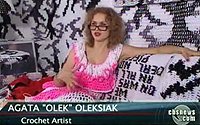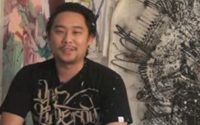In 2009, Nicola Verlato (one of the three artists in our upcoming Three-Handed exhibition) was an exhibiting artist in the 53rd Annual Venice Biennale, in the Italian Pavilion. Here are some images of the works and the installation…
.jpg)
.jpg)
.jpg)
.jpg)
.jpg)
.jpg)
.jpg)
.jpg)
Text by: Mirko Nottoli
Published in Collaudi (the Italian’s Pavillion catalog of the 53rd Venice Biennale)
Endowed with an uncommon command of technique, Verlato creates spectacular visions of apocalyptic scenarios and alien worlds under spacious vaulted heavens that depict stormy skies and mythological figures. The artist’s antinaturalistic and expressionistic use of colour, combined with his emphatic chiaroscuro and a taste for unusual perspectives that are framed in such as way as to suggest a gyroscope, have led some critics to call him a Mannerist or Baroque artist. In fact, the energy conveyed in his works, and the ferment implicit in his narrated material, recall Gaulli’s celebrated fresco in the Church of the Gesu in Rome, an illusionist feat that seems to break through the ceiling and rush up to a boundless space. The painter’s version of this Baroque style is decidedly contemporary, however, as he applies it to themes and contexts with which he feels an affinity, like rock music, skateboarding, and cartoons. The result is an art that is a cross between Altdorfer, Pop Art, manga, and heavy metal, in a visual arsenal of allusions that blend high culture and low culture. The complex process involved in creating such works combines cutting-edge technologies and others that are more traditional, ranging from 3D computer graphics, which Verlato uses for his reconstructions of perspective borrowed from Piero Della Francesca and Paolo Uccello, to clay models, a practice unchanged since the Renaissance. Indeed, the installation draws its inspiration from the intricate design of the great cathedrals, one of the most functional inventions—in terms of the narratives and symbolism they convey—in the history of art. Painting, architecture, and sculpture join to create a place in which they can interact and enhance each other’s qualities. Two fundamental themes run through Verlato’s work. One can be considered a narrative theme, that of the cyclical failure that follows on the eternal battle waged—in the framework of Western civilization, that is—by rationality against nature and random chance, as it tries in vein to prevail over the two. The other is an iconographic theme that corresponds to the need to structure the modernday myths of popular culture at the level of artistic output. At centre stage it is James Dean who steals the scene, filmed and reiterated on multiple formal levels, each of which corresponds to a sematic level. Indeed, Dean is a contemporary icon of mass culture, a symbol of both beauty and the tragedy of heroic gods and inevitably succumbs. Placed along the viewer’s path, which leads to a perfectly symmetrical space, the works incarnate the power of art to evoke that emotional state of suspended disbelief inherent in dreams and implicit in the sacred, as well. After all, according to Verlato, the artwork generates the sacred, not the other way around.






